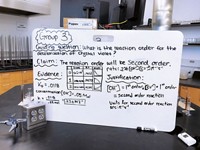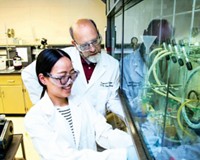Advertisement
Grab your lab coat. Let's get started
Welcome!
Welcome!
Create an account below to get 6 C&EN articles per month, receive newsletters and more - all free.
It seems this is your first time logging in online. Please enter the following information to continue.
As an ACS member you automatically get access to this site. All we need is few more details to create your reading experience.
Not you? Sign in with a different account.
Not you? Sign in with a different account.
ERROR 1
ERROR 1
ERROR 2
ERROR 2
ERROR 2
ERROR 2
ERROR 2
Password and Confirm password must match.
If you have an ACS member number, please enter it here so we can link this account to your membership. (optional)
ERROR 2
ACS values your privacy. By submitting your information, you are gaining access to C&EN and subscribing to our weekly newsletter. We use the information you provide to make your reading experience better, and we will never sell your data to third party members.
Policy
Showing Your Good Side
Simple tips can make filming lab demos go smoothly
by Carmen Drahl
February 8, 2010
| A version of this story appeared in
Volume 88, Issue 6

Making an instructional video to help students learn about lab procedures isn't as simple as just pushing the "record" button on a camcorder. Taking a few technological and performing tips into account will help produce a video that will serve as a valuable reference for students again and again.
In deciding what lab procedures to film, it's important to realize that not everything translates well to video, Massachusetts Institute of Technology chemistry professor Rick L. Danheiser says. But there is some "low-hanging fruit." A visual demo would be particularly valuable for lab techniques that involve specific hand motions or manipulations, he says. Titration, recrystallization, and distillation are just a few examples.
Many of the universities C&EN contacted have made videos covering at least one of those topics. What seems like each university reinventing the wheel is actually quite necessary, says Kimberly Berkowski, a former instructor of organic chemistry at MIT who helped develop some of the school's instructional videos. "We wanted to use the specific glassware that the students would be using so that there would be no confusion," she says. Glassware and instrumentation can vary widely from institution to institution, and although an experienced chemist might be able to adapt what he or she sees onscreen, a novice might have more trouble.
The lab space setup for filming should be free of clutter, Danheiser adds. "Reflections off glassware or busy backgrounds can make it difficult to see," he says.
During filming, "it's important to make every decision from the point of view of a learner," says Jim Yocom, director of instructional media services at Indiana University, South Bend. For students viewing the video on an iPod with a tiny screen, filming lots of close-ups helps them see the action.
Filming Tips from Indiana University, South Bend
Producing Lab Videos (PDF link)
Videotaping A Chemistry Lab (PDF link)
Choosing a camera angle that looks over the demonstrator's shoulder is also a good idea. "With that camera angle it's as though a student is looking at her own hands on the equipment," Yocom says. "Any other angle outside that, and students will have to mentally adjust for it," he adds. Filming from the corner of a lab table can help achieve that optimum angle.
The glassware isn't the only thing students will be watching. Although some chemistry videos available on YouTube don't depict the proper use of safety gear, it's important for universities to be able to stand behind their video content. "I'm adamant about always wearing the right safety gear," whether in lab or on camera, says chemistry instructor Cynthia Powell at Abilene Christian University, in Abilene, Texas.
When it comes to performing on camera, researchers can prepare in different ways, depending on their comfort level. Several chemists who spoke with C&EN prepared remarks in advance.
On the other hand, Pedro Bueno, a chemistry graduate student at the University of Maryland, simply talked his way through a procedure. "If I messed up, I'd stop and refilm," he says.
It's important to make sure the speech in the video is clear and not too rapid, Powell says. After learning that some students found her videos difficult to understand, she re-recorded segments where she had stumbled over phrases.
Finally, if funds allow, investing in a small tie-clip microphone called a lavalier microphone can dramatically improve a video's sound quality, Yocom says. The device avoids reliance on the camera's microphone—which might be positioned behind the speaker's back—for picking up speech.




Join the conversation
Contact the reporter
Submit a Letter to the Editor for publication
Engage with us on Twitter